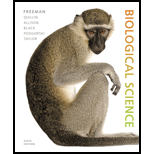
Concept explainers
Anton van Leeuwenhoek made an important contribution to the development of the cell theory. How?
a. He articulated that all organisms are made of cells.
b. He articulated that all cells come from preexisting cells.
c. He invented the first microscope and saw the first cell.
d. He invented more powerful microscopes and was the first to describe the diversity of cells.
Introduction:
The fundamental theory underlying the structural unit of life is known as cell theory. The cell theory is able to explain the structural unit, which is common in all the living organisms. The microscope development led to decoding the mystery about the fundamental unit and it confirmed that all the organisms are made up of cells. Anton van Leeuwenhoek was the first scientist to observe and describe the diversity of cells, such as blood cells, microscopic nematodes, and sperm cells.
Answer to Problem 1TYK
Correct answer:
Anton van Leeuwenhoek invented more powerful microscope and was the first to describe the diversity of cells. The efficient use of advanced magnification techniques, Anton van Leeuwenhoek observed the different type of cells.
Explanation of Solution
Explanation/Justification for the correct answer:
Option (d) is given as invention of the powerful microscope helped in describing the diversity of the cells. Anton van Leeuwenhoek was the first scientist who observes and describes the diversity of cells, such as blood cells, microscopic nematodes, and sperm cells. The magnifying power of microscopes was modified which resulted in the development of more powerful microscopes. Anton van Leeuwenhoek modified the magnifying power of microscopes, resulting in the invention of more powerful microscopes with magnification up to 300×. He was the first to observe the single-celled organisms and called them “animalcules”. Hence, Option (d) is correct.
Explanation for incorrect answers:
Option (a) is given as organisms made up of cells as an articulation. The claim was not just given by this scientist, rather a collective effort of scientists revealed that cells are the basic unit of all organism. So, it is a wrong answer.
Option (b) is given as the articulation that all cells have come from preexisting cells. This hypothesis was proposed by German scientist Rudolph Virchow. So, it is a wrong answer.
Option (c) is given as he invented the first microscope and observed by first cell Anton Van Leeuwenhoek. The first cell was observed by scientist Robert Hooke. So, it is a wrong answer.
In 1839, Schleiden & Schwann formally articulated that all organisms are composed of cells. A German scientist named Rudolph Virchow proposed that all cells arise from cells already in existence. Robert Hooke invented a microscope to examine the structure of cork from an oak tree. Leeuwenhoek further develop more powerful microscopes with magnification up to 300 ×; “×” refers to magnification power. Hence, the options (a), (b) and (c) are incorrect.
Anton van Leeuwenhoek made an important contribution to the development of the cell theory by inventing more powerful microscopes and was the first to describe the diversity of cells.
Want to see more full solutions like this?
Chapter 1 Solutions
Biological Science (6th Edition)
- Explain in a small summary how: What genetic information can be obtained from a Punnet square? What genetic information cannot be determined from a Punnet square? Why might a Punnet Square be beneficial to understanding genetics/inheritance?arrow_forwardIn a small summary write down:arrow_forwardNot part of a graded assignment, from a past midtermarrow_forward
- Noggin mutation: The mouse, one of the phenotypic consequences of Noggin mutationis mispatterning of the spinal cord, in the posterior region of the mouse embryo, suchthat in the hindlimb region the more ventral fates are lost, and the dorsal Pax3 domain isexpanded. (this experiment is not in the lectures).a. Hypothesis for why: What would be your hypothesis for why the ventral fatesare lost and dorsal fates expanded? Include in your answer the words notochord,BMP, SHH and either (or both of) surface ectoderm or lateral plate mesodermarrow_forwardNot part of a graded assignment, from a past midtermarrow_forwardNot part of a graded assignment, from a past midtermarrow_forward

 Human Biology (MindTap Course List)BiologyISBN:9781305112100Author:Cecie Starr, Beverly McMillanPublisher:Cengage Learning
Human Biology (MindTap Course List)BiologyISBN:9781305112100Author:Cecie Starr, Beverly McMillanPublisher:Cengage Learning Concepts of BiologyBiologyISBN:9781938168116Author:Samantha Fowler, Rebecca Roush, James WisePublisher:OpenStax College
Concepts of BiologyBiologyISBN:9781938168116Author:Samantha Fowler, Rebecca Roush, James WisePublisher:OpenStax College Biology Today and Tomorrow without Physiology (Mi...BiologyISBN:9781305117396Author:Cecie Starr, Christine Evers, Lisa StarrPublisher:Cengage Learning
Biology Today and Tomorrow without Physiology (Mi...BiologyISBN:9781305117396Author:Cecie Starr, Christine Evers, Lisa StarrPublisher:Cengage Learning Comprehensive Medical Assisting: Administrative a...NursingISBN:9781305964792Author:Wilburta Q. Lindh, Carol D. Tamparo, Barbara M. Dahl, Julie Morris, Cindy CorreaPublisher:Cengage Learning
Comprehensive Medical Assisting: Administrative a...NursingISBN:9781305964792Author:Wilburta Q. Lindh, Carol D. Tamparo, Barbara M. Dahl, Julie Morris, Cindy CorreaPublisher:Cengage Learning





